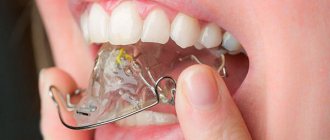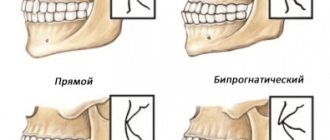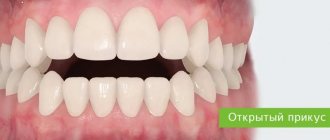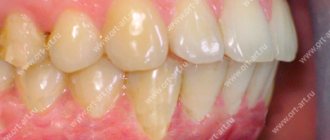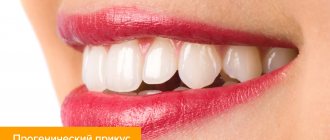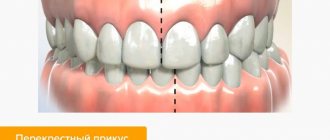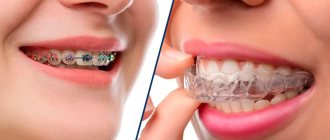Orthodontic treatment
is the process of correcting malocclusion. Experts say that about 90% of the world's population has some kind of defect in the arrangement of teeth. It’s just that for some it is clearly expressed, while for others it is quite well hidden and unnoticeable to others.
Orthodontic treatment with aligners is the most comfortable, fastest and most invisible to others!
I would like a consultation on orthodontic treatment with aligners!
However, there are also cases when the patient is satisfied with everything in his smile, but orthodontists strongly recommend that he correct his bite. This is due to the fact that incorrect positioning of teeth can cause serious problems not only with the patient’s teeth themselves, but also with health:
- Poor chewing of food due to loose teeth contacts is often the cause of stomach ulcers and diseases of the gastrointestinal tract.
- Malocclusion is an ideal environment for the development of periodontitis. With this disease, infections dominate the human oral cavity, often spreading to internal organs.
- In addition, there is a constant unpleasant odor in the mouth. Even if you brush your teeth often and use mouth fresheners.
- Malocclusion always affects the temporomandibular joints (TMJ). As an adult, a TMJ problem will cause many negative symptoms, such as severe headaches.
This is why orthodontists sometimes prescribe orthodontic treatment for malocclusion, even if the smile visually looks perfect.
Let's start with pediatric orthodontics. Many problems with a child’s teeth begin in early childhood and develop in kindergarten and early school age, but parents are in no hurry to take their child to a pediatric orthodontist. Why? Because many parents have this opinion:
From the experts
In addition to all the above recommendations, experienced orthodontists offer a number of tips based on practical observations:
- For adults, before installing braces, it is better to remove their wisdom teeth, even if they have not yet erupted, since there is a high risk of them being damaged by caries;
- When choosing a doctor, make sure that the examination is thorough. If the orthodontist suggests putting on braces right away, this is a bad sign. However, another recommendation indicates the low qualifications of the specialist - he suggests waiting to start treatment. Most likely, he does not understand how to solve your problem;
- it is very important to treat all teeth before correcting the bite; in addition, you must learn how to clean them correctly so that while wearing braces the enamel does not become caries;
- Soft tissue adjustments may be required before treatment. You should not be afraid of this; if the doctor suggested performing the procedure, then it is really necessary.
Skeptics believe that correcting a bite in adulthood is useless, and braces are only effective on children’s teeth. This is not a completely correct opinion, but in some ways they are right:
- more significant pressure has to be exerted on the teeth of an adult, which leads to painful sensations at the initial stage;
- some teeth have to be removed to make room for others;
- Bridges and crowns have to be removed during treatment, which also does not add pleasant moments to the procedure.
You should take your child to a pediatric orthodontist only when he has all his permanent teeth.
Orthodontist, candidate of medical sciences Tatyana Gevorkyan comments:
Unfortunately, this attitude towards orthodontic treatment among parents in childhood is a myth, very widespread and, alas, harmful. Very often, dentists themselves contribute to this myth about pediatric orthodontists. I don’t really want to comment on the degree of immersion in the issues of pediatric orthodontics of these specialists and their competence, but discussions about the advisability and necessity of the so-called early orthodontic treatment (that is, in childhood) do not subside to this day. And again, sometimes this situation actually happens: a child began undergoing orthodontic treatment in preschool or early school age, both the child and the parents tried, wore, and monitored the wearing of the orthodontic apparatus, and when the bite changed, the children’s orthodontist still installed braces. system...
A question immediately arises, mixed with parental indignation: why did the pediatric orthodontist have to “torment” the child for so long when he was given braces anyway?!! This is where this myth comes from: whatever one may say, braces are, like, the coolest thing for children’s and adult orthodontists, which solves all problems “at once.” But no! The braces system does not solve all the problems of orthodontic treatment in a child.
Orthodontic treatment in childhood is the fastest and most effective!
Growing patients—children and adolescents—are the most rewarding environment for a pediatric orthodontist to work in. Why? Everything is very simple and lies on the surface: in children and adolescents, the processes of growth, renewal, and metabolic processes are most active. Therefore, the same orthodontic force applied to a growing and non-growing patient can produce completely different results, with an advantage, of course, in growing patients.
In a very large percentage of cases, with timely initiation of orthodontic treatment in children, the need to install braces can be avoided. Here, of course, good, if not excellent, cooperation (that is, help from the pediatric orthodontist) on the part of the patient himself and, of course, the patient’s parents is extremely important, because children and adolescents very often still lack the motivation to follow the orthodontist’s recommendations. However, orthodontics is not magic... It also happens that the anomaly is so serious that the potential of simpler devices is not enough. In such cases, we, orthodontists, are forced to fix the braces in order to complete the treatment. But! A pediatric orthodontist should always warn parents that with conscientious early orthodontic treatment, we will in any case avoid more complex and severe pathology, thereby reducing the time of wearing braces in the future (or aligners in adolescence). This is also extremely important.
In this video, famous orthodontist Alexey Trezubov recommends young boys and girls to correct their teeth using aligners. They are invisible, light and comfortable to wear. Much better than braces, which are visible on the teeth, which you are tortured to brush constantly, since everything gets stuck in them and it is impossible to eat normally! In general, aligners are already a stable youth trend:
Thus, let’s sum up an intermediate result on orthodontic treatment in childhood: indeed, braces can correct a lot during orthodontic treatment, but wearing braces is a rather serious test for the body, and if there are options to avoid wearing braces or shorten the period of their use, then it is better do it. And early orthodontic treatment in children is the very option when it is possible to prevent a more serious anomaly, and therefore reduce the likelihood of the need for a pediatric orthodontist to install braces or reduce the likelihood of wearing them. Therefore, do not delay: it is better to go with your child, starting from the age of 3-4 years, for a consultation with a pediatric orthodontist and get all the information, than then frantically look for the most “light”, that is, easy options for solving problems where more serious orthodontic treatment is already required treatment with mouth guards.
Types of orthodontic structures
In addition to various treatment methods, there are several types of orthodontic structures. They can be divided into removable and non-removable.
Braces are non-removable, which means that the patient wears them without removing them. The only exceptions are preventive visits to the dentist for teeth cleaning, during which the braces are removed. Metal, ceramic, plastic, sapphire, gold - the doctor will tell you about the benefits and purpose of various braces. You should also know that depending on the degree of malocclusion or crooked teeth, you will be able to choose a certain type of design and installation of braces. So, lingual ones are installed on the back (inner) side of the teeth, but this method will not be effective if the symmetry of the dentition is severely disturbed.
Removable structures are divided into plates and mouthguards. They are used mainly to correct the bite and position of children's teeth, since in childhood the processes of correcting the bite occur many times faster. Mouth guards are a very popular way to treat defects; they do not need to be worn constantly and can only be used at home. But the effect of using mouthguards will be positive only if the curvature is very slight.
Sign up for a consultation at the Mira clinic and find out the answer to the question that worries you: whether you need to wear braces and how many years it will take. In our dentistry, you can calculate the full cost of correcting your bite and have the opportunity to pay in installments.
How is malocclusion treated during orthodontic treatment?
Today, orthodontists use several technologies that can correct misaligned teeth. There are many of them: plates, braces, aligners, twin blocks, etc. We'll show you the three most popular ones.
First technology - orthodontic plates
The main advantage of such plates is that they are removable. Depending on the condition of the bite, they can be worn around the clock or put on only at night. Due to the questionable effectiveness of treatments, they are practically not used, or are used only in the simplest cases.
The second technology of orthodontic treatment is braces.
Absolutely everyone knows about braces. Previously, these were ugly metal staples that turned the smile of the Jaws character from the James Bond film into a grin,
Today, braces are quite aesthetic and easy to use. According to the design on the teeth, braces are a permanent structure, that is, they are worn for a certain time (1-3 years), without ever being removed. Braces come in many types, such as self-ligating, ceramic, sapphire and lingual. Only the last of these, lingual braces, are invisible during orthodontic treatment.
The third technology of orthodontic treatment is aligners.
This technology, which appeared about 30 years ago, has reached us in a much improved form. The obvious advantage of aligners is that they are removable and invisible when worn. That is, the patient’s orthodontic treatment goes unnoticed by others. Even if a person corrects his teeth using this technology, no one will guess that he is wearing clear aligners. The disadvantage is that it does not correct all types of bites, although the most basic pathologies are easily treated with aligners.
The advantage of orthodontic treatment with aligners is the opportunity to see the results of your treatment BEFORE it begins. This opportunity is provided to the patient thanks to a special computer program - a virtual 3D setup. See for yourself how a bite is corrected using aligners, it’s a very exciting process:
Orthodontic treatment for straightening central upper teeth
This video discusses a case of orthodontic treatment, when a patient consults an orthodontist in order to correct the position of the two central incisors on the upper jaw: he has a changed position of one upper incisor (quite strong) - the incisor is rotated along the axis, and, let’s say, deviated with the edge forward.
That is, from a cosmetic point of view, we understand perfectly well that this is not a very beautiful position of the central teeth and, naturally, we want to correct it. The aligners dealt with this problem perfectly.
Orthodontic treatment of crossbite
The very name of crossbite already contains a small meaning of such a pathology, which is not always easy for orthodontic treatment. And the presented clinical case is no exception. In this case, the patient had a situation where the upper teeth, the upper dentition, are quite narrow. It turns out that the lower teeth OVERLOAD the outer surface of the upper teeth. Everything should be the other way around: our upper jaw should be wider and larger than our lower jaw. In addition, in the video we will see the deformation and incorrect position of the front teeth in the upper jaw, in particular, the so-called “lateral incisors”: they are in the posterior, palatal position. And again, as in the previous case, the aligners did an excellent job of solving the problem during the patient’s orthodontic treatment.
Orthodontic treatment when the fangs are crooked and need to be corrected
This video examines a rather interesting case. We will see with you not just the alignment of individual teeth and the magic of how aligners work, but we will also see HOW, with the help of aligners, we can correct the bite during orthodontic treatment.
Pay attention to the position of the lower canines. They are very much rotated along the axis. Orthodontists call this “rotation.” Therefore, here we present a rather complex movement during orthodontic treatment with aligners, a complex correction, since a canine is a fairly powerful tooth and we do not always easily cope with such problems even with braces. But again, the aligners did a great job!
Orthodontic treatment of crowded teeth using aligners
This video shows an example of a clinical case of crowded teeth, where not very straight front teeth become a beautiful, even, wide smile during orthodontic treatment with aligners.
Pay special attention to the upper jaw, where you can see excessive inclination of the front teeth, that is, when the teeth tilt very much back. In response to this, other teeth - the lateral incisors - visually seem to be tilted forward. From the inside we will see a not very even upper dentition, that is, the upper jaw has the shape of a trapezoid, the teeth are crowded, which is not the norm - after all, our jaw should be semicircular, semi-ellipsoidal, wide, bright.
And if you look at the lower jaw, you can also see a fairly high crowding of the teeth, a high, close position of the lower incisors. This is very common in almost all of us.
. And doctors very often hear from patients that it is very difficult to brush such teeth, and therefore there is a lot of dental plaque. With such crowded teeth, a person will always experience discomfort and seek professional hygiene.
As a result of orthodontic treatment with aligners, crowded teeth were completely eliminated and all the patient’s problems were a thing of the past!
Cost of orthodontic treatment with Star Smile aligners
The Star Smile company is a leading Russian manufacturer of aligners and therefore offers you the most comfortable and reasonable prices for orthodontic treatment. Star Smile is represented by certified specialists in more than 70 cities of Russia and neighboring countries.
Installment plans will also help you effectively begin orthodontic treatment: patients have the opportunity to undergo orthodontic treatment at a cost of:
- for the simplest case of correction from 6,000 rubles
per month - in the most difficult case of teeth straightening - less than 10,000 rubles
per month
Realistically, today these are the lowest possible prices for aligners in Russia!
Find out the prices for orthodontic treatment with aligners for your pathology
Methods of modern orthodontics
The method of treating malocclusion depends on the characteristics of the defect. Bite correction in adolescents and adults is always carried out using special devices or products that the patient wears on the teeth. In difficult cases, tooth extraction or surgery may be performed first. The dentist individually determines the treatment tactics and the type of orthodontic structure that will effectively and quickly make the dentition straight.
Bracket systems
Installation of braces for malocclusion pathologies is a classic. However, classic brace systems have been replaced by new design models that are characterized by maximum comfort while wearing them.
Modern braces, installed on the front side of the teeth, have thin plates made of materials that give the structure an attractive appearance. The material can be ceramic or artificial sapphire. In addition, the classic metal arc is replaced with a white one. For teenagers, the option of installing colored ligatures in different versions is relevant.
The most popular among adult orthodontic patients are lingual braces, which are installed on the back side of the teeth. This design is completely hidden from prying eyes and allows you to continue leading a business and even social lifestyle with maximum comfort.
It should be noted that even classic braces today no longer cause ridicule and bullying. On the contrary, installing a correction system on teeth is considered fashionable, since it is an indicator of a person’s care for his teeth and smile.
Aligners
A unique orthodontic system made of transparent material that remains invisible on the teeth even at close range. The aligners are made to match the entire dentition. The product is put on the teeth like a mouthguard, but unlike them, it has cells for each tooth and covers only the dentition only to the gum line, without going beyond it. Aesthetically, this system is flawless. The choice of many patients is also justified by the fact that the aligners do not need to be worn around the clock. You can take them off for an important meeting or date, and then put them back on again. The removable system allows you to treat other teeth without any difficulty.
From classic to modern
To treat malocclusion complicated by a lack of space in the dentition, incorrect position or size of the jaws, classic devices are used, improved thanks to modern technological capabilities.
Surgery in orthodontics
Modern methods in orthodontics also involve surgical intervention, performed mainly in adult patients. It is difficult to correct complex bite defects in an adult, since the dental system has already completed its formation and the bone tissue cannot be corrected. Methods of surgical intervention may involve removing teeth that caused uneven dentition, or surgically shifting the position of the jaws (osteotomy of the upper/lower jaw or genioplasty). Minimally invasive methods are used to perform operations, which make it possible to conceal the surgical intervention and avoid complications.
Orthodontics in modern dentistry has enormous potential for treating even complex malocclusions not only in children, but also in adults. Orthodontic treatment methods today combine all three important criteria: effective results, comfortable treatment and maintaining an attractive appearance during the correction period.
What else is important to know about orthodontic treatment?
- Sometimes, to successfully correct a malocclusion during orthodontic treatment, it is necessary to remove individual teeth. Often they are the ones that displace the remaining teeth and prevent the formation of a healthy bite. This operation may frighten you, but orthodontists do not offer unnecessary services if they really can be avoided.
- Before agreeing to treatment, make sure that the orthodontist you choose is qualified. Try to read reviews about this clinic on the Internet, ask around on the forums. The high cost of orthodontic treatment does not always indicate the professionalism of the orthodontist. There is no point in focusing on prices in this matter. Correcting a bite takes several years - and this is a considerable waste of time if the doctor suddenly turns out to be an inexperienced specialist.
- Many orthodontists prescribe treatment with braces, even if the patient chooses aligners. The reason is simple - braces must be constantly adjusted during treatment, which invariably leads to additional payments for the doctor’s work. With aligners, the orthodontist’s work is reduced to almost nothing, so the orthodontist will not be able to make money on you from monthly procedures either.
- Although you can undergo orthodontic treatment with aligners in more than 70 cities in Russia, naturally, treatment with aligners is not practiced in all clinics. This is also one of the reasons why orthodontists impose braces. You can view the list of clinics that work with aligners and make an appointment in your city on the Where to get treatment page.
- Finally, you must understand how much orthodontic treatment you need and what it involves.
Correction of position and curvature
For minor defects - crowding, uneven teeth, gaps between teeth - can be corrected with veneers or composite material. If significant correction of the bite is required, the patient is recommended to use braces. We offer patients several options for corrective systems, differing in the level of aesthetics, material and device. In the most difficult cases, surgical intervention is resorted to.
Orthodontic treatment with aligners is the most comfortable, fastest and most invisible to others!
Orthodontic treatment with Star Smile aligners is truly the most comfortable for you today and invisible to others.
The result of orthodontic treatment is always 100%. And - we predict! Star Smile orthodontists work in more than 70 cities of Russia, and we can offer you competent, detailed consultation in your city!
Do you want to consult on the problem of orthodontic treatment? We promise that after treatment with aligners you will forever forget about the malocclusion, which now causes you discomfort and, possibly, overloads the temporomandibular joint.
Advantages of using 3D technology for aligners
Thanks to them:
- The speed of service provision has increased, as the process of diagnostics, modeling and manufacturing of aligners has become digital and automated;
- Orthodontists have more accurate data that minimizes the risk of medical errors;
- It became possible to predict and visualize the final result of treatment and discuss it with the client;
- All information is saved: if the patient, for example, loses the aligners, it will be easy to make a replacement;
- It has become possible to manufacture aligners with the highest precision to date.
